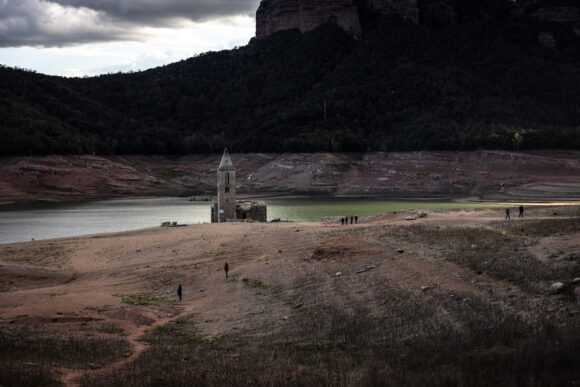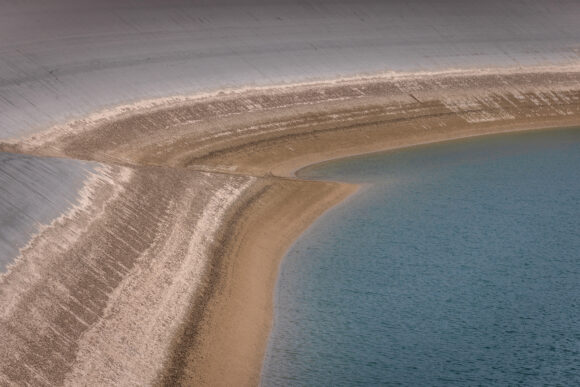Jana, Konrad, Laurence and Martinho — the unprecedented string of four named storms that barreled through the Iberian peninsula in the past three weeks — came with a silver lining: the likely end of Spain’s worst drought in recorded history.
The tempests tripled the amount of rain that usually falls on all of Spain during the first three weeks of March, according to meteorological agency Aemet. Cities like Seville, Cordoba and Madrid saw 10 times the usual amount of rainfall, with dozens of weather stations across the country registering monthly records.
“We’ll have to wait until the end of March to analyze the data, but it’s quite likely that the meteorological drought is over because rains in March have been very abundant,” said Aemet meteorologist Rubén del Campo. “Still, that doesn’t mean we have excess water.”
Spain Braces for More Downpours After Floods Kill Three People
Climate change is making some regions much drier, but also intensifying storms. Scientific models forecast that Spain and the broader Mediterranean region will become warmer and drier over coming years, with episodes of abundant rain concentrated in relatively short periods of time. That kind of cycle is conducive to flash floods as hardened, scorched soil fails to absorb sudden downpours.
The slew of storms that hit the Iberian peninsula this month was caused by a blocking low-pressure system in the north Atlantic Ocean that diverted storms toward lower latitudes, including France, Portugal and Spain. While some research points to greenhouse gas emissions impacting the North Atlantic Oscillation, the major wind current that drives big storms across northern Europe, there is no evidence that the recent rains were linked to climate change, Del Campo said.
Water reserves have climbed to about 66% of Spain’s total capacity, above the average for the past decade, according to data from the Environmental Transition Ministry through March 18. In Catalonia, the iconic Sau reservoir — known for a Romanic church that can be seen when water levels drop — has gone from holding just 3.9% of water capacity a year ago to 52% on March 24, according to a daily report by Catalan water agency ACA. Now, only the bell tower can be seen.

But even though the situation in Catalonia’s Mediterranean basins has improved, ACA doesn’t consider the drought there to be over, said an agency spokesperson. While some water restrictions that impacted millions of people over the past three years have been lifted, areas including Barcelona remain under drought alert, with public fountains shut and irrigation of public and private gardens restricted to certain days and times.
The storms brought record rain to Madrid, with the country’s oldest meteorological station reporting the highest amount of rain for any month since at least 1893. The city’s Manzanares river — usually a thin stream barely deep enough for ducks and other birds to dip their feet in — threatened to overflow as authorities emptied full reservoirs upstream to prevent dams from bursting.
Up in the Guadarrama mountain range, two ski resorts that in recent years suffered from lack of snow are attracting thousands of Madrileños keen to race across unusually high levels of powder. The Valdesqui Resort registered 5 meters (16 feet) of snow, second only to a record in 1996.
Elsewhere, rains resulted in streams and rivers overflowing, leading to at least three deaths and forcing the evacuation of hundreds of people in the region of Andalusia. Roads were cut and trains halted in Spain and Portugal as authorities issued amber alerts for wind, rain and waves.
In the back of everyone’s mind was the Oct. 29 tragedy in Valencia, when a violent downpour resulted in over 200 deaths and billions in insurance losses. Now, a judge and a Senate commission are investigating whether better coordination and communication between different local and regional authorities and agencies could have saved lives.
“The ugliest face of climate change hit Spain at the end of last year — the storm in Valencia,” Spain’s Minister for Environmental Transition Sara Aagesen said on the sidelines of the Petersberg Climate Dialogue in Berlin on Tuesday. “It’s important to talk about mitigation, or reducing emissions, but also about adaptation.”
Top photograph: Water level lines on the upper reservoir of the La Muela hydroelectric power plant, operated by Iberdrola SA, in Cortes de Pallas, Spain, on Tuesday, June 27, 2023. Photo credit: Angel Garcia/Bloomberg
Topics Windstorm
Was this article valuable?
Here are more articles you may enjoy.



 Questions About How a Deputy’s Stepson Became the Accused Gunman at FSU Shooting
Questions About How a Deputy’s Stepson Became the Accused Gunman at FSU Shooting  Global Q1 Commercial Insurance Rates Drop 3%, but US Casualty Bucks the Trend
Global Q1 Commercial Insurance Rates Drop 3%, but US Casualty Bucks the Trend  State Farm Wins Dismissal of Class Action Over Xactimate Software
State Farm Wins Dismissal of Class Action Over Xactimate Software  Trump’s Trade War Is Making US Farmers Anxious About Demand Risk
Trump’s Trade War Is Making US Farmers Anxious About Demand Risk 

